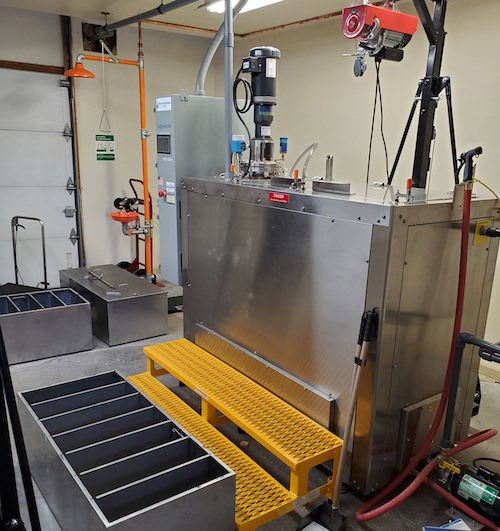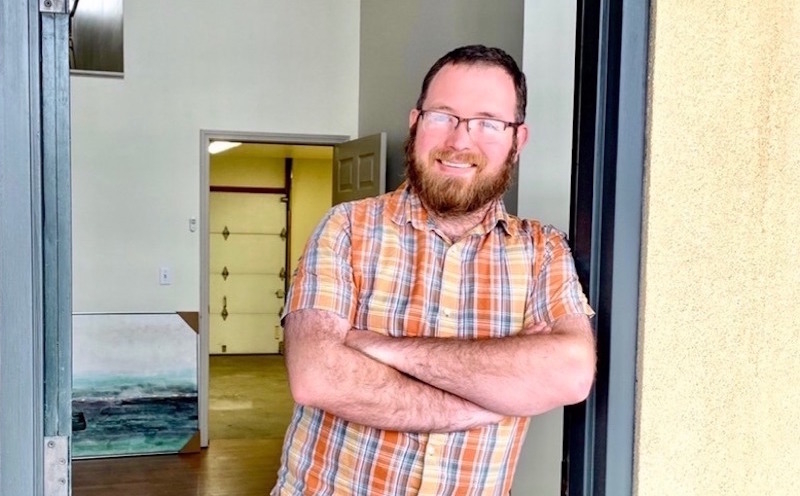When the final day comes for a beloved pet, there is now a gentler option to cremation that is also easier on the environment, using less energy for a smaller, aftercare carbon footprint.
In August, Jarrod Hammond opened Heartland Pet Aquamation in Kansas City to offer pet aquamation, an alternative to cremation. Instead of using fire, the water-based process uses alkaline hydrolysis for the final disposition of pet remains. The process uses 90 percent less energy than flame cremation, and the water usage is comparable to what would be needed to give a pet a bath, said Hammond.

Aquamation uses a water-based, alkaline hydrolysis process as an alternative to fire-based cremation.
Aquamation takes about a day to complete. It begins with placing the pet remains in a private cradle, adding alkaline solvent and water, and then using circulating heat to accelerate the natural decomposition process. When the cycle is finished, what remains are inorganic minerals and a sterile mix of water and basic organic compounds such as salts, sugars, peptides and amino acids. The solution is drained, and the remains are dried before being processed into ashes that will be returned to the family in a 100-percent biodegradable, bamboo-based container.
Alkaline hydrolysis completely breaks down all bacteria and viruses, and the remaining solution is neutralized to a safe pH before discharge, Hammond said. The final output, or ‘effluent’, of amino acids, peptides and sugars could also be used as a fertilizer, which Hammond is considering offering in the future. The remaining water is sterile and is released back into the water system.
“It’s really rare to find a green substitute for something that directly improves on every aspect,” Hammond said. “So, it’s cool to present an option that makes being greener so easy.”
Even though the majority of Hammond’s services will be for cats and dogs, he has already provided services for a gerbil and a hedgehog and has the capacity for an animal up to 500 pounds. Pricing ranges from $90 (for gerbil size) to $250-plus for an animal that weighs more than 100 pounds.
Hammond has a detailed process for ensuring that owners receive their own pet’s remains. However, communal aquamation is available, and is less expensive, for owners who do not want the ashes. Those remains will be spread on local farmland.
“Transparency is very important to me, so I encourage people to ask questions or schedule a tour to see our services,” He said.
Heartland Pet Aquamation is currently the only service of its kind in the Kansas City area. Hammond has already helped a pet owner who drove to Kansas City from Minnesota with her pit bull. She had done her research and found that Hammond’s services were the closest to her home near Minneapolis.
Hammond didn’t start out looking for a greener option to cremation, but philosophically he wanted to start a business that was better for the environment. When his job at Cerner got caught in a round of layoffs last year, the software consultant and father of three saw an opportunity to start his own business. His extensive research led him to the aquamation process. He originally wanted to offer the human version, but he said it was much more complicated and expensive, and he thought the pet version might be a better entry point.
“We tend to be death phobic in the U.S., where as other countries honor the dead,” he said. “So, this seemed like a good way to make aquamation more acceptable.”
Aquamation is allowed in 18 states for human remains, and for the past 25 years has been used by the Mayo Clinic and UCLA Medical School for the final disposition of human remains.
Pet owners interested in aquamation services can contact Hammond directly or request the service through a veterinarian. To schedule a tour, a pet pickup or drop off, or get more information, contact Hammond at info@heartlandpetaquamtion.com or 816-710-0123. Heartland Pet Aquamation is located in the West Bottoms at 1414 Wyoming St., Suite 9, Kansas City, MO.

This is interesting information. My green burial will be much less energy consuming (aside from transport and the human kCals expended) and provide more resources back to the environment. I’m interested in the total resource costs regarding the process, production and shipment (latter likely coal based) of chemicals needed to perform this, water usage and cleaning/sterilization, source of energy (e.g., solar/wind vs. coal/natural gas), etc., and what is done with the effluvia. Also, the woman who drove from MN to KC did not contribute to saving the environment.
This is a really old comment, but Robin – you are correct that your green burial will have less env impact assuming you don’t have any metal implants in your body. If you do have metal implants, a Life Cycle Assessment (which considers cradle to grave, all the things you mentioned) would show that aquamation would have the lowest env impact….. but even flame cremation would have lower env impact than green burial – because the metals would be recycled and stay in the usage loop. At the end of the day, these decisions are usually about more than just impact. It’s about personal preference, too. Or honoring a deep love. I love green burial and I think it’s a beautiful option. LCAs show the lowest impact material to be a plain cardboard box for green burial. Meh… If you envision being wrapped in a family quilt, maybe a shroud, or placed in a wicker backet, that sounds nice. The idea of having family and friends pick some sprigs of whatever is in season and place them about, and being buried in a meadow for green burial – then do that – metal implants or not. We all nip and tuck what we can where we can in life for the environment. It’s good we think about it in every facet of life. All of these options are wonderful choices. I’m glad my grandpa’s bulletproof metal casket he loved so much will be a rarity someday. It sure was pretty, and I’m glad he got what he wanted, but my 7 & 9 yr old kids are growing up in a different world.